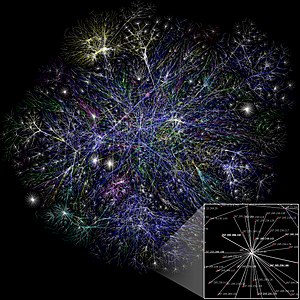 Image via WikipediaI do not work in a nano-deficient environment. At my university (UMass-Lowell) we have what we call the "Nano Queens", three female scientists who excel in this field, and a new building is rising on our North Campus that will be dedicated to nanotechnology, among other things. So, I think of myself as nano-aware. But, Barbara Herr Harthorn's article "Methodolocial Challenges Posed by Emergent Nanotechnologies and Cultural Values" in Hess Biber's edited volume--The Handbook of Emergent Technologies in Social Research (65-88)--has taken me to new heights. Harthorn is definitely the nano-babe of social science research (in my eyes).
Image via WikipediaI do not work in a nano-deficient environment. At my university (UMass-Lowell) we have what we call the "Nano Queens", three female scientists who excel in this field, and a new building is rising on our North Campus that will be dedicated to nanotechnology, among other things. So, I think of myself as nano-aware. But, Barbara Herr Harthorn's article "Methodolocial Challenges Posed by Emergent Nanotechnologies and Cultural Values" in Hess Biber's edited volume--The Handbook of Emergent Technologies in Social Research (65-88)--has taken me to new heights. Harthorn is definitely the nano-babe of social science research (in my eyes).Her piece took me back immediately to the first article in the book, by Edward Hackett, and the issues he raises about researching in the new scientific and technological environment of today. Her piece provides many specific illustrations to fill in the general ideas he discussed.
Nano queens, Nano buildings, and Nano babes aside--Harthorn makes it clear that defining the nano is not all that easy, and, thus, researching it is just that much more complicated. Nano is in the process of becoming, it is quintessentially emergent, so research of the issue is "upstream". In other words, you are in the business of identifying, finding, describing. This danger is well noted when she says:
Social scientists and humanists recruited to study NSE processes for technological development are thus at some risk of creating the very object we are studying, of reifying a category that may have little inherent meaning outside the funding world (71)
As an ethnographic, feminist social science researcher, Harthorn has had a unique opportunity to be in on the beginnings of the nano world through participation in the Center for Nanotechnology in Society at the University of California at Santa Barbara. Her article makes excellent reading because the social science that she is describing, she has lived!
Of the points I take away with me from this reading, one is related to interdisciplinary research (a point Hackett also raises)...and this point is also related to the issue of researching those things that are "upstream" as she defines the emergent world of nanotechnology...and this is that true, dynamic interdisciplinarity is required to get at these forming masses that span science, social science, and the humanities. Having scientists, social scientists (of diverse backgrounds and skills) and John and Jane Q Public together at the table is probably the only way to get at the potential good (and bad) of these extremely powerful, but as yet, emergent technologies.
I am also drawn to her discussion of the importance of mixing qualitative and quantitative in order to be open enough to discovery of what you haven't imagined and, simultaneously, primed to track down what you have identified. Harthorn recommends use of a methodological toolkit that is constantly evolving itself, always being honed to address specific questions and situations that may not have been imagined by methodologists from an earlier era. This experimentation in methodology has led her to team to develop "deliberative forums" and to make use of "experimental deliberation" as well as new forms of web surveys. She charts an interesting pathway in the social sciences. From lab-based experiments, social scientists moved out into the world to focus on behavior and practices in their real or natural locations, but now with new communication media we can move back into another kind of lab where we can engage with a much wider range of people in a virtual space (a kind of lab) asking them to reflect on their behaviors, practices, decisions, and potential outcomes (a kind of naturalized perspective).
The article is worth much, just for the bibliography alone. Harthorn's close connection with the development of this field--the social study of nanotechnology--has given her access to a vast amount of the material that is being released on this topic. She shares her riches generously with the reader.







